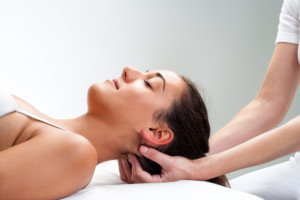Chiropractic For Headache Treatment

Whether they are mildly annoying or severely debilitating, headaches are never a welcome addition to anyone’s day. Statistically speaking, nearly half of Wellington’s adult population will likely suffer from a headache this year, with around 11% having a migraine. There are over 100 types of headache classifications, each with their own pain patterns, causes and treatment options.
Chiropractic treatment has been shown to help with some common forms of headaches and may be able to help you. To find out how, we must first look into the two broad types of headaches called primary and secondary headaches.
Primary Headaches
Primary headaches occur on their own without an underlying medical condition. The exact mechanisms that cause the headache is unknown. Primary headaches include:
– Tension type headaches: The most common headache, causing mild to moderate pain, felt as tension or pressure on both sides of the head and are not aggravated by physical activity.
– Migraines: These cause moderate to severe pain, are usually felt as a pulsating pain in one side of the head and are aggravated by physical activity. They can also cause nausea, visual disturbances (known as aura) and sensitivity to light and sound.
– Trigeminal autonomic cephalgias (TACs): A group of headaches known to affect one area of the head. They are usually moderate to severe in intensity, reoccurring and located around the eyes or temples, possibly causing eye redness, tearing and nasal symptoms.
– Others primary headaches: Less frequent and/or less understood types including headaches brought on by coughing, exercise, sexual intercourse, cold temperatures, pressure and sleep.
Secondary Headaches
Secondary headaches occur as a result of an underlying medical or neurological condition. The brain lacks the ability to detect damage to its own neural tissue, so the discomfort suffered with these headaches actually originates from one of the various surrounding tissues or structures in or around the head. Below is a list of secondary headache types and examples of underlying conditions:
– Conditions related to the cranium, face and neck structures: Sinus and ear infections, eye disorders and neck dysfunction.
– Trauma: Whiplash, brain injuries and fractures.
– Vascular disorders: Stroke, intracranial bleeds and malformations.
– Non vascular disorders: Inflammatory diseases, tumours, abnormal spinal fluid pressure and seizures.
– Substance exposure: Medication overuse and withdrawal, alcohol and drug usage.
– Infection: Meningitis, encephalitis and brain abscess.
– Disorder to homeostasis: High altitudes, diving, fasting, dehydration and even space travel!
Is Chiropractic An Effective Headache Treatment?
Secondary headaches can be caused by neck dysfunction. These are known as cervicogenic headaches, originating from the cervical spine (otherwise known as the neck). Like many other headaches, the exact cause of the cervicogenic headache remains unclear but it is theorised that an issue arises from the sensory information coming from the structures within the neck, similar to the spinal dysfunction theory mentioned on our research page. Chiropractors aim to improve spinal dysfunction using manipulative therapy allowing the return of normal nervous system function and muscular control.
To summarise this idea:
Neck dysfunction → Headache → Chiropractic treatment → Improved neck function → Improved headache 😃
 Research indicates that manipulative therapy (such as chiropractic care) can in fact help headaches. A significant, highly cited study commissioned in 2010 found that spinal manipulation is an effective form of treatment for cervicogenic headaches and migraines in adults.
Research indicates that manipulative therapy (such as chiropractic care) can in fact help headaches. A significant, highly cited study commissioned in 2010 found that spinal manipulation is an effective form of treatment for cervicogenic headaches and migraines in adults.
Manipulative therapy may also affect the most common type of headache, the tension type headache. A systematic review of the literature published between 2000 and 2013 concluded that “the results suggest patients with TTH receiving manual therapies showed better progress than those receiving conventional treatment or placebo” however effectiveness could not be assessed and that further, high quality studies were needed.
Signs your headache may be coming from your neck:
- Pain in the neck felt radiating around the head
- Tight and sore muscles felt around the base of the skull
- Pressure on the upper neck muscles affect the headache severity
- Previous injury to the neck
- Pain aggravated with neck movement
- Limited ranges of neck motion
Signs you should seek out urgent medical care for your headache:
If you are suffering from a headache it is important to get a professional diagnosis and treatment. Signs you should seek urgent care include:
- Confusion, drowsiness or trouble understanding speech
- Fainting
- Seizure
- A high temperature
- Numbness, weakness or paralysis felt anywhere in the body
- A stiff neck
- Trouble seeing, speaking or walking
- Nausea or vomiting
- Sudden onset of severe headache

